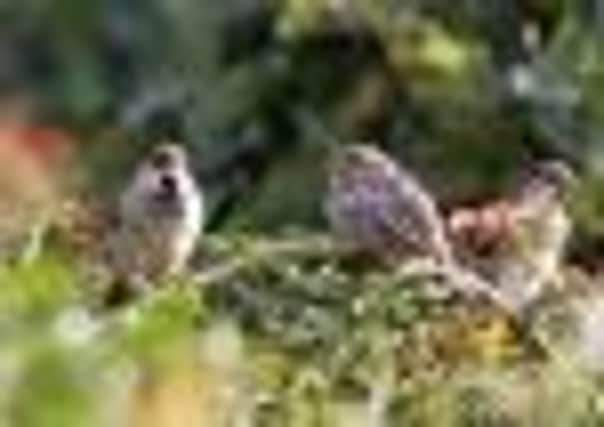Outdoors: The humble sparrow has been our most common garden visitor since the Stone Age, but we shouldn’t take them for granted


Seldom have I come across a more sedentary group of birds, for they rarely seem to wander more than a few hundred feet from the handful of front gardens found at the end of our street. They are so lacking in wanderlust that only very occasionally will they even bother to venture around the side of our house and into the back garden, despite there being plenty of feeding opportunities on the bird table.
Instead they are perfectly happy in their little area of street and front garden, finding plenty of food on the small grassy lawns and in among the hedges and bushes. It is almost as if they seem to enjoy the kraal-like protection offered by the semi-circle of houses, and even as I write there is a pair nesting under the roof tiles of the house opposite. These house sparrows are the cheerful cheeky chappies of the bird world, constantly chirping come rain or shine and always in the company of others.
Advertisement
Hide AdWatching the frenetic energy of their antics and the way they like to socialise and interact with each other is always fascinating. The house sparrow prefers to nest in loose colonies and I imagine it is the constant noise and activity around such sites that has given rise to their reputation as being somewhat promiscuous birds. Indeed, the house sparrow was associated in classical mythology with Aphrodite, the goddess of love. But the truth is rather less racy as they are in fact very loyal birds and in most instances will stay faithful to their partners and nest sites for life.
Known as the sproug in Caithness or the spurgie in Aberdeenshire, and in other parts of Scotland as the spug, speug or spuggie, it is hard to imagine a bird that is more closely associated with people – it has been living around our dwellings since the Stone Age.
Although the widely used term “cock sparrow” is one of endearment, the bird has had a somewhat chequered relationship with mankind in the past because of its propensity to be a bit of a pest on farmland, especially when large flocks roam across cornfields feeding avidly on the seeds. This led to the creation of Sparrow Clubs in the 18th and 19th centuries where people were encouraged to kill as many sparrows as possible in return for a small bounty. Sparrow pie was a popular country dish in many areas, although one reference from the 16th century referred to the bird as being “hard of digestion”. Our familiarity with sparrows means it is very easy to take their presence for granted, which is something we should never do as they have experienced startling declines throughout much of the UK since the early 1970s. This alarming fall has been most pronounced in England, although on a more local scale a particularly large slump was noted from central Edinburgh. While the decline in England continues, recent survey data suggests the Scottish population has stabilised and may even be on the increase again.
In rural areas, the reason for the recent sharp fall is probably down to changes in farming practices that has led to the loss of winter stubbles and improved hygiene measures around grain stores. A reduction in weeds on agricultural land may have also resulted in fewer seeds and insects to feed upon. Environmental pollution has been cited as a possible factor in some urban areas, as has a reduction in potential nesting sites due to house refurbishment projects. Insects are particularly important for house sparrows to feed their young and in our towns the increased use of garden pesticides combined with the trend to pave front gardens for parking and the laying of decking in the back is also likely to have played some role in the recent decline due to the adverse impact this has on invertebrate populations.
This leads to the rather inevitable conclusion, and no doubt one my neighbours will have already reached, that the small but thriving colony of sparrows in the street where I live is a direct reflection of the scruffiness of my front garden. The uncharitable may regard it as the lazy option, but given the choice, I would rather have my little group of cheerful cheeky chappies any day than a pristine lawn and a flowerbed devoid of weeds.